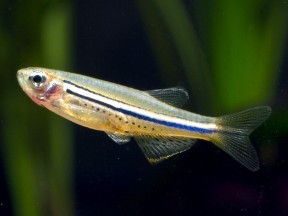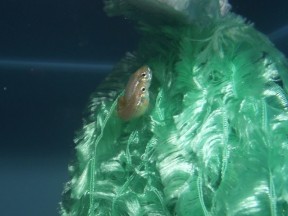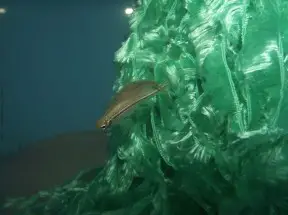Brachydanio nigrofasciata
Dwarf Spotted 'Danio'
SynonymsTop ↑
Barilius nigrofasciatus Day, 1870; Brachydanio nigrofasciatus (Day, 1870); Danio nigrofasciatus (Day, 1870); Danio analipunctatus Boulenger, 1911
Etymology
Brachydanio: from the Ancient Greek βραχύς (brakhús), meaning ‘short’, and Dhani, a Bengalese vernacular term for small, minnow-like cyprinids.
nigrofasciatus: from the Latin niger, meaning ‘black’, and fasciatus, meaning ‘banded’.
Classification
Order: Cypriniformes Family: Cyprinidae
Distribution
Endemic to Myanmar but its range doesn’t appear to extend into the north as sometimes reported, rather it seems restricted to central parts of the country in the divisions of Yangon and Bago as well as Mon State.
It’s been recorded from the Ayeyarwady/Irrawaddy River drainage and the Sittaung and Bago rivers so occurs on both sides of the Pegu/Bago Yoma (mountain) range.
The type series was apparently collected at two localities; close to Mawlamyaing (formerly Moulmein) city in Mon and near Bago (formerly Pegu city) in Bago Division.
Habitat
Inhabits streams, minor rivers and still bodies of water including ponds, ditches and rice paddies.
Many if not all habitats are likely to be seasonal in nature as Myanmar is heavily affected by seasonal monsoons and thus experiences a relatively cool, dry period between November and April and a very hot, wet season from May until September/October.
As a result many streams and rivers become partially dried out for part of the year but flow strongly during the monsoon.
A March 2008 survey by a team from the Swedish Museum of Natural History recorded this species at several localities, one of which was the Dayame Chaung (Dayame stream), close to the township of Daik-u, Bago Division.
From images it certainly appears that the stream undergoes seasonal drying as large sections of the muddy bed were exposed. Sympatric fishes at the locality included Brachydanio albolineata, Puntius sophore, Lepidocephalichthys guntea, Dermogenys pusillus, Badis ruber, and Colisa labiosa plus unidentified Esomus and Microrasbora (probably Microdevario) spp.
Maximum Standard Length
30 – 40 mm.
Aquarium SizeTop ↑
Base dimensions of 60 ∗ 30 cm or equivalent should be the smallest considered.
Maintenance
Looks particularly effective in a heavily-planted arrangement with a darker substrate, and may appear paler in sparsely-decorated set-ups.
We suggest maintaining it in a well-planted aquarium or set-up designed to resemble a flowing river or stream, with a substrate of variably-sized rocks and gravel and some large water-worn boulders.
Additional powerhead(s) or filter outlets can be used to provide flow but torrent-like conditions should be avoided since small danionins tend to occupy calmer stretches and marginal zones in nature.
Driftwood roots, branches and aquatic plants, with hardy genera such as Microsorum, Bolbitis or Anubias ideal since they can be grown attached to the décor, can also be added.
The aquarium must have a very tightly-fitting cover as members of this genus are accomplished jumpers and can fit through surprisingly small gaps.
Water Conditions
Temperature: 18 – 26 °C
pH: 6.0 – 7.5
Hardness: 36 – 215 ppm
Diet
Almost certain to prey chiefly on insects and their larvae in nature. In the aquarium it’s largely an unfussy feeder and will accept most foods.
A good quality dried product or two can be used as the staple diet but this should be supplemented with regular meals of small live and frozen fare such as bloodworm, Daphnia, Artemia, etc., for the fish to show the best colouration and conditioning.
Behaviour and CompatibilityTop ↑
Very peaceful but doesn’t make an ideal community fish due to its adult size and rather timid nature.
It will do best when maintained alone or with similarly-sized species that enjoy similar conditions.
Other small fishes from Myanmar such as Celestichthys choprae, Brachydanio aesculapii, Microdevario spp., Pethia phutunio, Acanthocobitis zonalternans, Yunnanilus and Akysis spp. make excellent companions, and we suspect it might also do well alongside some species normally recommended for non-community aquaria such as Parambassis lala, Dario hysginon or D. sp. ‘Myanmar’.
It’s a schooling species by nature and should be maintained in a group of at least 8-10 specimens.
Maintaining it in decent numbers will not only make the fish less nervous but result in a more effective, natural-looking display while males will also exhibit their best colours as they compete with one other for female attention.
Sexual Dimorphism
Sexually mature females are usually rounder-bellied, less colourful and a little larger than males.
The differences are especially clear when the fish are in spawning condition as the males intensify in colour and the females fill with eggs.
Reproduction
Like many small cyprinids this species is an egg-scattering spawner that exhibits no parental care.
That is to say when the fish are in good condition they will spawn often and in a densely-planted, mature aquarium it is possible that small numbers of fry may start to appear without human intervention.
However if you want to increase the yield of fry a slightly more controlled approach is required.
The adult group can still be conditioned together but one or more smaller, say 10-15 litre, containers should also be set up and half-filled with water.
These should be very dimly lit and the base covered with some kind of mesh of a large enough grade so that the eggs can fall through it but small enough so that the adults cannot reach them.
The widely available plastic ‘grass’-type matting can also be used and works very well; alternatively filling part of the tank with spawning mops, Java moss or other fine-leaved plant can also yield good results.
The water itself should be of slightly acidic to neutral pH with a temperature towards the upper end of the range suggested above.
A small power filter can be added initially and this should be positioned so that the flow is directed down the full length of the tank.
When the adult fish are well-conditioned and the females appear full of eggs one or two pairs should then be introduced to each container.
Spawning can be initiated by adding small amounts of cool water every few hours in such a way that the tank is gradually topped up and feeding small amounts of live and frozen foods.
The adults will eat any eggs they find and are best removed after a couple of days at which point the power filter should be switched for a mature sponge-type unit in order to avoid fry being sucked into the mechanism.
Incubation is temperature-dependant to an extent but usually takes 24-36 hours with the young free-swimming a couple of days later.
Initial food should be Paramecium or a proprietary dry food of sufficiently small (5-50 micron diameter) grade, introducing Artemia nauplii, microworm, etc. once the fry are large enough to accept them.
This species is less fecund than most congeners with a female typically relweasing 20-50 eggs per spawning event.
NotesTop ↑
This species used to be readily available in the aquarium trade but in the last few decades has been quite scarce.
According to Fang (1998) it’s most easily distinguished from similar-looking species such as B. rerio and B. kyathit by the spotted anal-fin plus it lacks a longitudinal stripe above the P+1 stripe and has a much narrower P+1 stripe in comparison with the P stripe.
In recent years it’s become commonplace to refer to the stripes on the body and fins of danionins as follows:
– P stripe: or “pigment stripe” is the central, dark, lateral stripe on the body which extends into the caudal-fin in some species. Stripes above it are numbered P+1, P+2, etc. and those beneath P-1, P-2, P-3.
– A stripe: the central stripe on the anal-fin; the proximal stripe (above it) is A+1 and the distal stripe (beneath) A-1.
– D stripe: The submarginal dorsal-fin stripe.
Following Fang (2003) Brachydanio spp. are characterised by the presence of an A stripe on the anal-fin and two or more P stripes on the caudal, plus some internal characteristics such as enlarged nasal lamellae.
The genus has undergone some significant taxonomic reshuffling in recent years following the publication of a series of phylogenetic studies.
Older, molecular, phylogenies tended to agree that it represented a monophyletic group consisting of two major clades; the ‘Danio devario‘ group containing the larger, deeper-bodied species and the ‘D. rerio‘ clade comprising the smaller, slimmer fish.
However in 2003 Fang conducted a more detailed study based on morphological characters which included members of other related genera, and the results suggested for the first time that the genus Danio as previously considered represents a polyphyletic grouping, i.e., not all members derived from a single common ancestor.
The genus name Devario was suggested for the larger species with Danio being applied only to the smaller fish (with the exception of the type species, D. dangila which can grow to around 89 mm SL). Recent molecular studies by Mayden et al. (2007) and Fang et al. (2009) resulted in further changes, with the latter study considering the genus Danio to be composed of three subclades. These were subsequently split into distinct genera by Kottelat (2013), as follows:
The former species D. erythromicron, D. margaritatus, D. choprae and D. flagrans are grouped together in the revalidated genus Celestichthys Roberts, 2007. These exhibit unique body patterning consisting of vertical bars (C. erythromicron, C. choprae, C. flagrans) or light spots (C. margaritatus) and possess either very short barbels or none at all.
The genus Danio contains only the type species, D. dangila, separated on the basis of its larger size and the shape of the caudal-fin, which in adults is only slightly emarginate or even truncate in shape, a feature it shares only with Tinca tinca (the common tench) among other cyprinids.
The remaining species, of which B. rerio is thought to be the most ancient, are included in the revalidated genus Brachydanio Weber & de Beaufort, 1916.
References
- Day, F., 1870 - Proceedings of the Zoological Society of London 1869 (pt 3): 614-623
On the freshwater fishes of Burma. Part I. - Conway, K. W., W.-J. Chen and R. L. Mayden, 2008 - Zootaxa 1686: 1-28
The 'Celestial Pearl danio' is a miniature Danio (s.s) (Ostariophysi: Cyprinidae): evidence from morphology and molecules. - Fang, F., 1998 - Ichthyological Exploration of Freshwaters 8(3): 273-280
Danio kyathit, a new species of cyprinid species from Myitkyina, northern Myanmar. - Fang, F., 2003 - Copeia 2003(4): 714-728
Phylogenetic Analysis of the Asian Cyprinid Genus Danio (Teleostei, Cyprinidae). - Fang, F., M. Norén, T. Y. Liao, M. Källersjö and S. O. Kullander, 2009 - Zoologica Scripta 38(1): 1-20
Molecular phylogenetic interrelationships of the south Asian cyprinid genera Danio, Devario and Microrasbora (Teleostei, Cyprinidae, Danioninae). - Kottelat, M., 2013 - The Raffles Bulletin of Zoology Supplement 27: 1-663
The fishes of the inland waters of southeast Asia: a catalogue and core bibiography of the fishes known to occur in freshwaters, mangroves and estuaries. - Mayden, R. L., K. L. Tang, K. W. Conway, J. Freyhof, S. Chamberlain, M. Haskins, L. Schneider, M. Sudkamp, R. M. Wood, M. Agnew, A. Bufalino, Z. Sulaiman, M. Miya, K. Saitoh, S. He, 2007 - Journal of Experimental Zoology, Molecular Development and Evolution 308B: 642–654
Phylogenetic relationships of Danio within the order Cypriniformes: a framework for comparative and evolutionary studies of a model species. - Roberts, T. R., 2007 - Raffles Bulletin of Zoology 55(1): 131-140
The 'Celestial Pearl Danio', a new genus and species of colourful minute cyprinid fish from Myanmar (Pisces: Cypriniformes).







